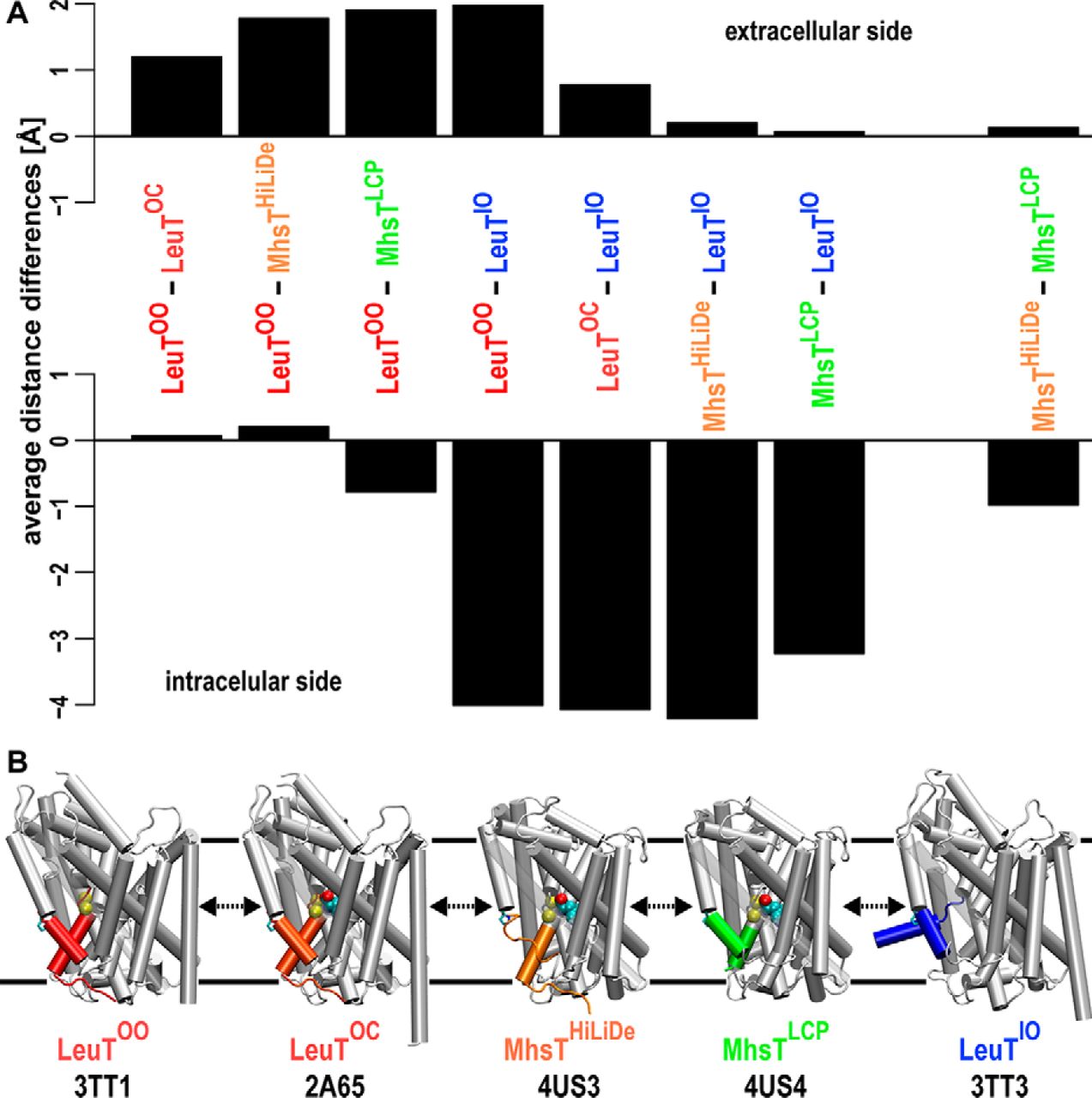The role of transmembrane segment 5 (TM5) in Na2 release and the conformational transition of neurotransmitter:sodium symporters toward the inward-open state
By Sebastian Stolzenberg, Zheng Li, Matthias Quick, Lina Malinauskaite, Poul Nissen, Harel Weinstein, Jonathan Javitch, and Lei Shi.
Published in J Biol Chem. 2017 May 5;292(18):7372-7384. PMID: 28320858. PMCID: PMC5418039. Link to publication page.
Project: The Transport Cycle in Neurotransmitter Uptake Systems. Core Facility: Computational Modeling.

Figure 3.The MhsT structures represent intermediate states between the outward-occluded and inward-open states of LeuT. In A, MhsT crystal structures (MhsTHiLiDe and MhsTLCP) are compared with the LeuTOO, LeuTOC, and LeuTIO structures with regard to their extent of opening at both the intracellular and extracellular sides using the same comparison as Fig. 2 and summarized by the average distances difference on the extra- and intracellular sides. B is a cartoon showing the relative position of the MhsT crystal structures (MhsTHiLiDe and MhsTLCP) compared with the LeuTOO, LeuTOC, and LeuTIO structures in the transport cycle, according to A. Each structure is distinguished by a different color for the NT/TM1i and TM5i/TM5m regions; the bound substrate and sodium ions are shown as colored and yellow van der Waals spheres, and the side chain of the conserved Pro in TM5m (Pro-181 for MhsT and Pro-200 for LeuT) is rendered as sticks.
Abstract
Neurotransmitter:sodium symporters (NSSs) terminate neurotransmission by the reuptake of released neurotransmitters. This active accumulation of substrate against its concentration gradient is driven by the transmembrane Na+ gradient and requires that the transporter traverses several conformational states. LeuT, a prokaryotic NSS homolog, has been crystallized in outward-open, outward-occluded, and inward-open states. Two crystal structures of another prokaryotic NSS homolog, the multihydrophobic amino acid transporter (MhsT) from Bacillus halodurans, have been resolved in novel inward-occluded states, with the extracellular vestibule closed and the intracellular portion of transmembrane segment 5 (TM5i) in either an unwound or a helical conformation. We have investigated the potential involvement of TM5i in binding and unbinding of Na2, i.e. the Na+ bound in the Na2 site, by carrying out comparative molecular dynamics simulations of the models derived from the two MhsT structures. We find that the helical TM5i conformation is associated with a higher propensity for Na2 release, which leads to the repositioning of the N terminus and transition to an inward-open state. By using comparative interaction network analysis, we also identify allosteric pathways connecting TM5i and the Na2 binding site to the extracellular and intracellular regions. Based on our combined computational and mutagenesis studies of MhsT and LeuT, we propose that TM5i plays a key role in Na2 binding and release associated with the conformational transition toward the inward-open state, a role that is likely to be shared across the NSS family.


